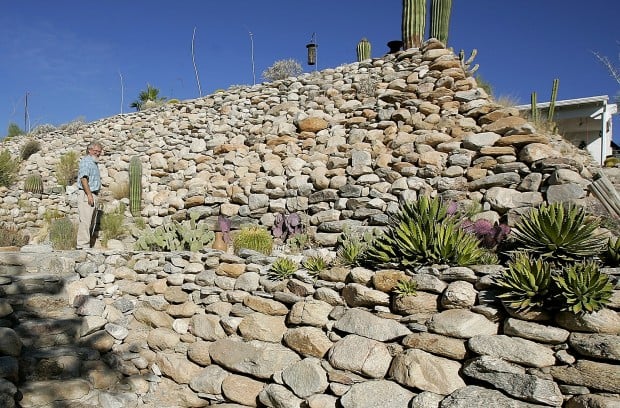One of Tucson's man-made wonders was rendered invisible 20 years ago, hidden behind a retaining wall.
Those who lived or traveled on the northwest side in the 1980s and early '90s still remember the marvel known as "The Great Wall of Ina."
A landscaped backyard at 1322 E. Thunderhead Circle features four tiers of walls built by John and Betty McCullough that slope down 75 feet from a patio to East Ina Road.
Hot-air balloon companies would point it out to passengers. Movie legend Lee Marvin, who lived on the northwest side before he died in 1987, once remarked about the wall, "Those people must be crazy to be working so hard."
Barbara Criswell of Sunset magazine called the wall "interesting and innovative."
"It was an unusual thing, and it showed a lot of ingenuity. It seemed to solve a lot of problems, too."
The wall still exists, but it's no longer visible from the road.
The county filled in a 15-foot dip in front of the house in order to improve Ina and finished a noise-blocking retaining wall in 1992. The new, not-so-great Wall of Ina is 15 feet tall and 460 feet long, much of it along the property, obscuring it from drivers.
"I wanted to shoot myself. It literally destroyed the wall," Betty told the Tucson Citizen in 1992. "John was speechless. He was sick for two days. … It took a few men three months to destroy what it took us more than six years to build."
The couple moved to Tucson from Ohio in 1980. John built the wall to stop county personnel from cutting through his property to check a sewer line meter. He did it without blueprints or any wall-building experience.
John posted signs on the street corner asking for pool companies and construction firms to drop off their excess dirt and stone to help out. Companies complied, dropping between 300 and 350 truckloads on the property.
"We did spend all our time building. We never took a holiday," Betty told the Citizen in 1992.
"We stayed home, and we worked and we worked and we worked. We did all of it ourselves. We'd be out at daybreak on hot days, seeing people go by with their motor homes and boats, and here we'd be rolling rocks and throwing dirt."
John endured charley horses, a sore back and blisters as he worked between eight and 10 hours, five or six days a week, over an initial two-year period building the wall, quitting his job as a plasterer in order to devote more time to the project.
John was 56 when he completed the wall in 1983. He continued less frequent work on it until 1987, fortifying the wall against erosion.
The work caused him to shed 30 pounds and gain a dark tan.
Betty died in May 2005, and John died two months later.
Pat Constantino, 69, and her husband, Bob, 71, have lived in the house since 2006.
"It's decorative," Pat said of the Great Wall of Ina. "It's a beautiful place to walk down through the different levels. Each level has a different kind of cactus."
Constantino said no one comes by to ask to look at the wall. She's hoping people remember it.
"We'd like to get a plaque to put on the house that says 'The Great Wall of Ina,' " she said. "That's our goal. Just so people don't forget."
The origins of Ina
Read the story behind how Ina Road got its name in Tuesday's Street Smarts column in the Tucson & Region section.
Got an oddity?
Is there something you've noticed while driving through Tucson that has piqued your curiosity? Or is there some piece of Old Pueblo history you've wondered about? Drop us a line, and we'll look into it.
Contact the Star newsroom at oddity@azstarnet.com or 807-7776.
Contact reporter Phil Villarreal at 573-4130 or pvillarreal@azstarnet.com





